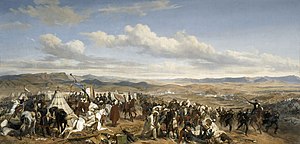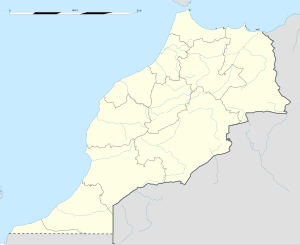TheBattle of Isly(Arabic:معركة إيسلي) was fought on August 14, 1844, betweenFranceandMorocco,near theIsly River.French forces under MarshalThomas Robert Bugeaudrouted a much larger, but poorly organized, Moroccan force, mainly fighters from the tribes ofBeni Snassen,but also from theBeni AngadandBeni Oukil;[3]underMuhammad,son of the Sultan of Morocco,Abd al-Rahman.Bugeaud, attempting to complete theFrench conquest of Algeria,instigated the battle without adeclaration of warin order to force negotiations concerning Moroccan support for theAlgerian resistanceleaderAbd el-Kaderto conclude on terms favorable to the French[4]who demanded the Sultan of Morocco to withdraw support for Abd el-Kader.[5]
| Battle of Isly | |||||||
|---|---|---|---|---|---|---|---|
| Part of theFranco-Moroccan War | |||||||
 Battle of Isly,oil painting byHorace Vernet. | |||||||
| |||||||
| Belligerents | |||||||
|
|
| ||||||
| Commanders and leaders | |||||||
|
|
| ||||||
| Strength | |||||||
| 10,400 soldiers[1] | 45,000 soldiers[1] | ||||||
| Casualties and losses | |||||||
|
27 killed 99 wounded[2] |
800 killed 1,500 wounded[1] 11 artillery | ||||||
Location of the Battle of Isly | |||||||
Bugeaud, who recovered the Moroccan commander's tent and umbrella (equivalent to capturing a military standard in European warfare), was madeDukeof Isly for his victory.
The day following the battle, theBombardment of Mogadorstarted.[6]
Background
editSince theInvasion of Algiers in 1830,Emir Abd el-Kaderhad taken lead of the tribes of the region ofMascarato oppose the French in 1832.A first treaty,signed byGeneral Desmichelsin 1834, was deemed too favorable to him. in 1837,Marshal Bugeaudwas therefore instructed to sign a new one, theTreaty of Tafna,which required Abd el-Kader to recognize the sovereignty ofFrance in North Africa,in exchange for which France recognized the authority of Abd el-Kader over a large part of Algeria; the wholeBeylik of Oran(with the exception of the cities ofOran,Arzew,MostaganemandMazagran), theBeylik of Titteriand theBeylik of Algiers(with the exception of the cities ofAlgiersandBlida), as well as the plain ofMitidjaand theAlgerian Sahel.[7]
The Sultan of MoroccoAbd al-Rahmanattempted seizingTlemcenfrom the French in October 1830. The Sultan sent 5,000 cavalry and infantry. Moroccan soldiers rampaged through the streets of Tlemcen, looting and fighting. The Sultan eventually had to retreat them.[8]
Nevertheless,Abd el-Kadernever turned down his will to drive the French out of Algeria. To this end, he requested and obtained the support of the Sultan of MoroccoAbd al-Rahman,in which in theory he was a vassal of the Moroccan sultan,[9]as well as the concession of the territory located betweenOujdaand theTafna River.Abd el-Kader had raised a real army, and in November 1839, supported by the Sultan of MoroccoAbd al-Rahman,he declared war on France, following the crossing of theBibans(Iron Gates) by the French army.[10]
In reaction, the French then truly undertook the systematic conquest of the country, which theJuly monarchymade a reason for national pride and military heroism. This conquest was the work ofMarshal Bugeaud,appointed governor in 1840. Abd el-Kader saw his capital destroyed inTaguinin 1843 following theBattle of the Smalaand was driven back into thedesert.He then took refuge inMorocco,but, at the same time, the army of SultanAbd al-Rahmanwas defeated atIsly,while the French fleetbombarded the portsofTangierandMogador.After three years ofguerrilla warfare,Abd el-Kader surrendered toLamoricièrein 1847.[11]
Prelude
editOn 30 May, French troops ofGeneral Bedeauhad to repel a Moroccan attack.[12]The MoroccanQaidcrossed the border intoLalla Maghnia,a place sixty kilometres fromTlemcen,and attacked the French camp with his Moroccan cavalry.[12]The attack was soon repulsed byGeneral Lamoricière.The next dayMarshal Bugeaudembarked atAlgiers.[12]On 15 June, Moroccan troops fired upon French troops, wounding Captain Daumas and two men, demanding that the border must be set back to theTafna River.On the 19th, French troops occupiedOujda.[12]
Battle
editOn 6 August,Tangierhad beenbombarded by French shipscommanded byFrançois d'Orléans,a son of the King of France,Louis Phillippe I.[13]
The Governor General having assembled all his forces, made up of 11,000 men, marched on the Moroccan camp established atDjarf el-Akhdar,a short distance fromOujda,on the right bank of theIsly River,a sub-tributary of theTafna River.[4]
Having to deal almost exclusively with cavalry, he had formed from his infantry a large diamond whose faces were themselves made up of small squares. The cavalry was in the interior of the lozenge which marched through one of its angles duly provided with artillery.[14]
At daybreak, seeing the French army advance, the Sultan sent the Moroccan cavalry with a mass of 20,000 to 25,000 cavalry. This charge did not succeed in forcing the lines oftirailleurs,and was soon separated in two by the squares of the advancing cavalry.Bugeaudthen brought out his cavalry. This formed by echelons, charged the Moroccan cavalry which was to the left of the army and dispersed it after having defeated several hundred of its cavalry. The first echelon, composed of six squadrons ofspahiscommanded byColonel Joseph,rushed to a Moroccan camp and captured eleven pieces of artillery. The Moroccan artillerymen did not have time to reload.[15]
The Moroccaninfantrydispersed inravineswhere the Frenchcavalrycould not pursue them. While the first echelon marched on the camp, the second commanded byColonel Morrismoved on the part of the Moroccancavalrywhich was on the right. It was a difficult endeavor. After it was over, the French army concentrated on the Moroccan camp, and soon set out in pursuit to prevent them from rallying.[14][16]
Consequences
editAs a result of the battle, the French captured elevenpieces of artillery,eighteenflags,and all the Moroccantents.The Moroccans had 800 of their men killed when the French had 27 of their men killed and 99 of them wounded.[15]
References
edit- ^abcClodfelter, M. (2017).Warfare and Armed Conflicts: A Statistical Encyclopedia of Casualty and Other Figures, 1492-2015(4th ed.). Jefferson, North Carolina: McFarland. p. 199.ISBN978-0-7864-7470-7.
- ^Pierre Montagnon,The conquest of Algeria: The seeds of discordie,2012.
- ^"La bataille d'Isly, ou l'engagement constant du Maroc envers le Maghreb".Sahara Question.13 August 2020.Archivedfrom the original on 26 October 2020.
- ^abHekking, Morgan."The Battle of Isly: Remembering Morocco's Solidarity With Algeria".Morocco World News.Archivedfrom the original on 22 September 2020.Retrieved11 August2021.
- ^Churchill, Charles Henry (1867).The Life of Abdel Kader, Ex-sultan of the Arabs of Algeria: Written from His Own Dictation, and Comp. from Other Authentic Sources.Chapman and Hall. p. 236.
- ^E.J. Brill's First Encyclopaedia of Islam 1913-1936.BRILL. 1987. p. 550.ISBN978-90-04-08265-6.
- ^"Battle of Isly | Algerian-French history".Encyclopedia Britannica.Retrieved11 August2021.
- ^Miller, Susan Gilson (15 April 2013).A History of Modern Morocco.Cambridge University Press. p. 14.ISBN978-0-521-81070-8.
- ^Miller, Susan Gilson (15 April 2013).A History of Modern Morocco.Cambridge University Press. p. 15.ISBN978-0-521-81070-8.
'Abd al-Qadir was careful, however, not to appear to challenge 'Abd al-Rahman's own claims of suzerainty, and made it known that he was acting merely as the Moroccan sultan's khalifa, or deputy. Still in theory a vassal of the Moroccan sultan
- ^Nodier, Charles (2004).Journal de l'expédition des portes de fer(in French). SERRE EDITEUR. p. 319.ISBN978-2-906431-76-8.
- ^"La bataille d'Isly | Histoire et analyse d'images et oeuvres".histoire-image.org(in French).Retrieved11 August2021.
- ^abcdd'.), Henri Amédée Lelorgne Ideville (comte (1884).Memoirs of marshal Bugeaud, from his private correspondence and original documents, 1784-1849, ed. from the Fr. by C.M. Yonge.pp. 112–118.
- ^Sondhaus, Lawrence (4 May 2004).Navies in Modern World History.Reaktion Books. p. 71.ISBN978-1-86189-202-7.
- ^abTerrasse, Henri (1952).History of Morocco.Éditions Atlantides. p. 148.
- ^abPennell, C. R. (2000).Morocco Since 1830: A History.C. Hurst & Co. Publishers. p. 49.ISBN978-1-85065-426-1.
- ^Wagner, Moritz (1854).The Tricolor on the Atlas: Or, Algeria and the French Conquest.T. Nelson and sons.
